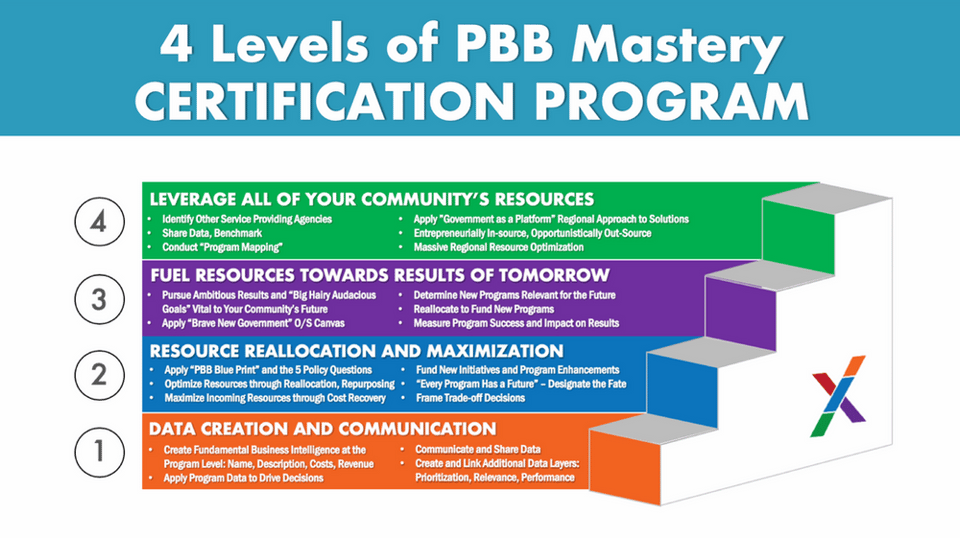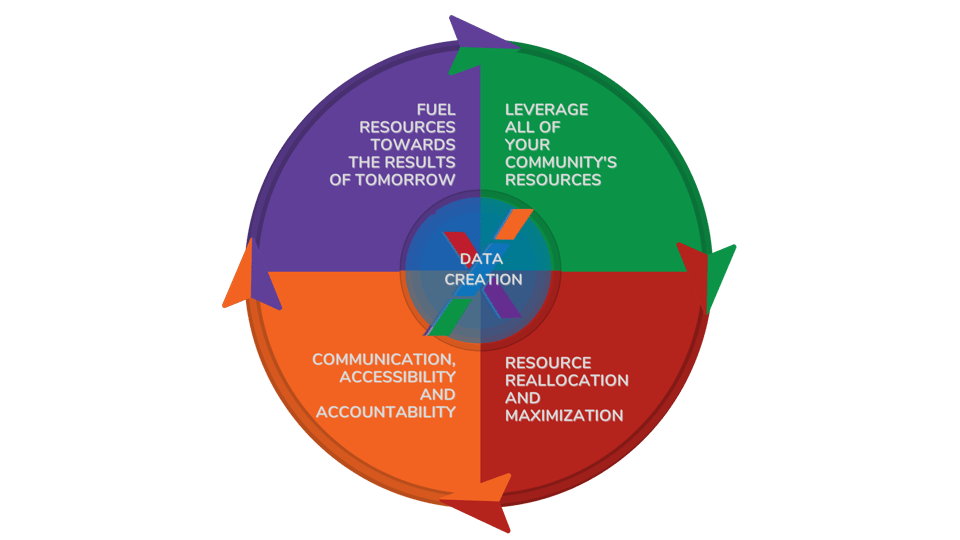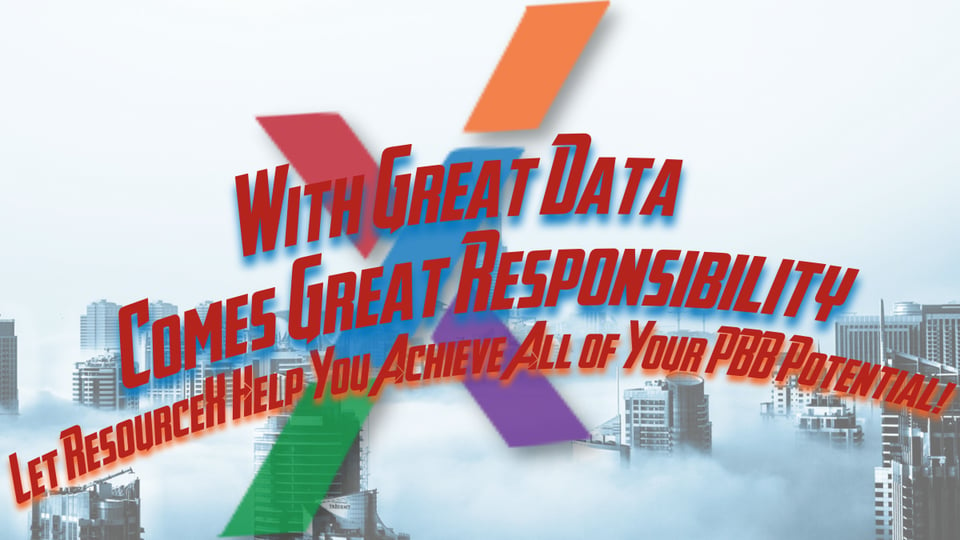"We believe that in order for local government leaders to succeed in a data-driven era, we're going to need to create more insightful data and we're going to need new skills and clear ambitions to most prosperously put data to use. This is what the 4-Levels of PBB Mastery are all about: what data will we need to create, and what ambitions must we strive for as we apply the data?"
At the 2019 PBB Summit in Denver, we announced the upcoming rollout of an evidence-based program to recognize an organization's mastery of a new and vital set of skills to allow data-driven decision making to flourish. The program is designed to accelerate mastery in programmatic decision-making and resource optimization, advancing expertise in applying the uniquely insightful data produced throughout PBB, to attain any or all among four specific levels of ambition that we call "the 4-Levels of PBB Mastery."
We believe that in order for local government leaders to succeed in a data-driven era, we're going to need to create more insightful data, and we're going to need new skills and clear ambitions to most prosperously put data to use. This is what the 4-Levels of PBB Mastery are all about: what data will we need to create, and what ambitions must we strive for as we apply the data?
At the heart of the PBB Movement is the realization that so much is "up to local government" and it's partners to tackle for the creation and sustainability of a better world, and if there's one thing for sure it's that we're going to need resources to pursue viable solutions.
The challenge is that resources can seem scarce, and therefore the PBB approach systematically uncovers all available levers one can pull to free up and reallocate (repurpose) the current resources already collected, and to maximize new revenue opportunities to fuel the future they're trying to build.
We believe deeply in the role of local government and the good that it was created to do - our chosen role is to help local government leaders solve the resource equation and thereby unlock the restraints holding organizations back from launching and enhancing the programs vital for a prosperous future.
Therefore concept of the “4-Levels of PBB Mastery” shows every policy maker, every executive and administrator, every department head, budget analyst and organizational leader, how to take the practice of resource mastery and reframe it as the practice to fuel the future we wish to create.
4 Levels of PBB Mastery
The blunt challenge is that most organizations have plenty of new programs and services they wish they could to launch, they have absolutely no shortage of phenomenal ideas and innovations to initiate in order to create a brighter future for their communities; but they perceive that they don’t have the people nor the money to launch anything substantial or ambitious.
Compounding that challenge, for many, is that the cost of providing current services continues to increase, putting additional strain on the resources available to achieve the Results that matter most to their citizens.
This is why the status quo persists in most organizations - not because of a lack of great ideas, and not because of a lack of drive to tackle their community's most pressing challenges, but because of a limiting and debilitating belief that there's just not enough money to fund new programs.
Most excitingly, organizations who are mastering the 4-Levels are showing that resources are more readily available than we might have believed. Applying PBB to master each level, organizations are discover solutions to optimize their current resources, and explore opportunities to attain new resources in order to successfully launch the new programs and bolster the highest priority programs required to create the best future they can.
The purpose of the 4-Levels, therefore is to create a practical vehicle to discover and take advantage of every opportunity to free-up and reallocate resources, as well as to maximize new revenue, in order to fund the programs required to produce a better future.
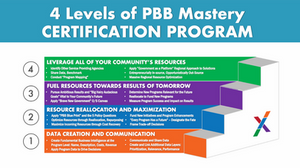
Level 1: Data Creation and Communication
First, get the data. Mastery at the foundational level is about getting data and learning to use data routinely in decision-making. Identify the programs you offer and the price for delivering each program.
Further layer data such as community outcomes, and even performance metrics to add insight as to the alignment (or lack thereof) of your organization’s resources with the results you’re striving to achieve.
Communicate this information. Use it as the basis for budgetary decisions. Use data as the basis for any decision - within the budget process and/or outside the budget process.
Mastering data-driven communication, and applying data in routine decision making is the foundational goal of Level 1.
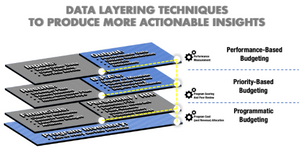

Case Studies in Level 1:
Marathon County WI - opening dialogue in community newsletter about programs and trade-offs, applying PBB
City of Duluth MN - working with local news officials to tell the story of the "price of snow."
City of Branson MO - created infographics to describe programs and results in Budget in Brief document
City of Longmont CO - launched Open PBB Data website to share program information (programs, costs, influence on results) with their public
City of Lawrence KS - launched Open PBB Data website to share program information with residents
Level 2: Master Resource Re-allocation and Maximization
Take action on the data produced via program-based, priority-based and/or performance-based budgeting.
Repurposing: Shift resources away from programs that can be provided more efficiently for the same outcome, programs that are less relevant and could be provided at a lower service level (or sunset), programs that are performing poorly, or programs that could be provided with a partner, and repurpose those resources towards new programs that need to be launched, or current programs that need enhancement.
Maximization: seek to maximize incoming resources through cost-recovery opportunities shown in the data, regionalization and in-sourcing opportunities, grant funding, opportunity zones, economic development, philanthropic commitments, and taxation.
During the 2019 PBB Summit, 7 organizations were honored as the first to receive Resource Optimizer and Resource Maximizer Awards, including: Washington County WI, City of Shawnee KS, City of South Jordan UT, City of Branson MO, Scott County MN, City of Plano TX and the City of Kalamazoo MI.
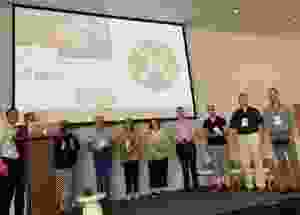
Among the Resource Optimizer Award recipients were the first 5 organizations having demonstrated successfully that they have repurposed over 10% of their entire budgets, freeing up the massive resources required to launch new and high-priority services, as well as enhancing current programs that need to grow. The goal is to transition the aspirational concept of 10% budget repurposing from a "massive stretch goal" to something that everybody can achieve.
It's a mind-blowing milestone for the PBB community of implementers because most/many local governments don't believe they could repurpose much of anything in their budget (they feel most of what they do, they have to continue to do, because it's either mandated, or their elected officials insist on it, or their citizens demand it) - our first five organizations achieving 10%+ reallocation of their resources unlocks the potential that maybe local governments have more opportunity to free up readily available resources than they may otherwise assume to have.
Level 2 is about mastering the simplicity of two techniques: divesting resources away from programs (people's time, as well as non-personnel expense), and becoming adept and generating new revenue (in all ways beyond tax), and therefore mastering the framework for action on the right side of the PBB Blue Print.
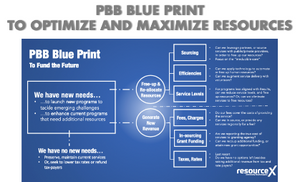

Case Studies in Level 2:
First Five Communities to Demonstrate 10%+ Reallocation of Resources
City of Littleton CO - applied PBB Blue Print for budget recommendations (to launch new programs, to enhance current services, to repurpose resources through efficiencies and service levels, and to generate new revenues through cost recovery.
City of Roswell GA - applied PBB Blue Print to focus on programs with cost recovery opportunities (see pigs 26-41 for cost recovery recommendations driven by program analysis)
Level 3: Master Result Setting – Tackle Massive Challenges
With mastery over resource reallocation techniques, re-imagine what outcomes you’d set out to achieve if resources weren’t the limiting factor.
Freed from the restriction of the perception “we don’t have the money” or “we don’t have the staff” or “we don’t have the partners” to launch the programs you’d desire to launch to create a better future, what programs would you launch? What outcomes would you seek?
Seek to establish ambitious goals that provide for a higher quality of life for everyone, and drive your organization's resources towards the programs you need to get into. The point of Level 3 is that when a local government feels like they actually have the resources available to take on big commitments, they will: just ask Kalamazoo MI.
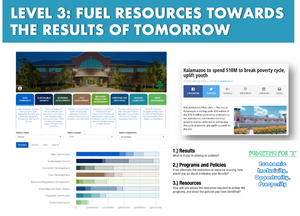

Case Studies in Level 3:
City of Kalamazoo, MI - applying PBB to break poverty cycle, fuel resources towards Imagine Kalamazoo
City of Littleton, CO - applying PBB to fund Envision Littleton
Level 4: Master Regional Resource Optimization
The only limitation of “Level 2” and “Level 3” is that your organization will reach a limit: a state of optimization where there are no more advantageous trade-offs left to consider. Not that an organization has to wait until this point of optimization to pursue “Level 4” whatsoever, but the idea here is to leverage and partner with other service providers who are aligned in their work with the results your organization is striving to achieve, and take advantage of their efforts, their resources, as if your organization and theirs were one and the same.
Massive regional resource optimization can be achieved via Program Mapping and entails understanding what other organizations provide, and where it would be advantageous for your organization to opportunistically outsource various programs (leveraging other entities who can provide them just as well, or retire them altogether), regionalize to jointly provide programs together (public-private partnerships, or merged services provided more efficiently together), or entrepreneurially in-source programs to maximize incoming resources.
Program Mapping is our way to facilitate Level 4 mastery, which aims to help your organization master 2 skills:
1.) Entrepreneurially, is there an opportunity to in-source programs entirely to provide to the other partner, as a more efficient model of service delivery where one of the cities is positioned better to provide the service regionally. This would be a revenue generating opportunity to the in-sourcing city, and ideally an efficiency (resourcing the service, for less) to both entities given the economy of scale that could be produced.
2.) Opportunistically, is there an opportunity for advantageous out-sourcing – where one could imagine getting services off of their plate, reducing the need for their own city to provide a service if it could be provided by their neighbor. And in turn, allowing their city to “free up and reallocate” their own resources towards the high priority pursuits (new programs they need to launch, or current services that need enhancement) that they may not be able to fund today.
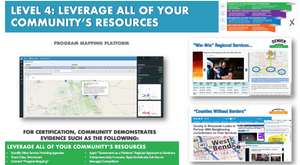
Case Studies in Level 4:
Washington County, Wisconsin – launched "Counties Without Borders" between the County and the four adjacent county governments.
City of Shawnee, Kansas – Program Mapping with over 20 local service providers to participate in their Program Match-up. Participants ranged from two local school districts, the neighboring cities of Lake Quivira and Merriam, Johnson County, the City of Kansas City Parks, Shawnee Community Services, and private sector businesses including the Holiday Inn Express, and the Chamber of Commerce.
Clear Creek County, Colorado – Program Mapping with over 40 organizations from across the County, representing cities, schools, private sector leaders, hospitals, and park districts.
Moffat County, Colorado – Program Mapping with the County, the county-seat (City of Craig), Memorial Regional Hospital, Northwestern Community College, and the Moffat County School District.
The 4-Levels of Mastery is also designed to help your organization track it's progress, by submitting evidence so that ResourceX may recognize/"certify" your mastery at each and every one of the 4-Levels. This may help your elected officials, citizens and leaders at all levels of the organization who are wanting to know: "how will we be accountable for using the data, how will we know we're making progress, how will we measure if PBB is actually taking hold and gaining traction?"
Summary
Taken together, each of the resource mastery levels entails a focus on programs, the resources you are willing to allocate, and the outcomes you’re striving to achieve. The purpose of mastering each level is to become adept at determining the programs and services your organization should launch to achieve the outcomes that matter most for your future, programs that need enhancement to improve your community, programs you can leverage partners to provide, programs you can provide more efficiently, programs you can provide at a lower service level or retire all together, and programs you can bring in more resources with.
In a newly coined turn of phrase, let the purpose of resource mastery be known as reprogramming your organization. And let us reiterate that the purpose of reprogramming is not limited to solving the resource alignment objective, but expand to “reprogramming” the way work works within local government and throughout it’s network of community partners to produce the results we all seek to create the best possible future for humanity.
To learn more about "A New Skill Set For Data-Driven Decision-Making: The 4-Levels of PBB Mastery" contact Erik Fabian to schedule a free webinar.
